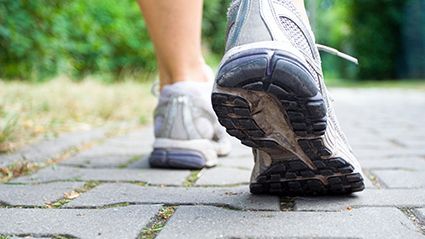
Fast-paced walking is painful for the millions of people with peripheral artery disease (PAD). But new research shows that a slower, pain-free pace won’t cut it if improvement in mobility is the goal.
The study included more than 300 of the roughly 8.5 million Americans with PAD. It’s a condition in which plaque build-up in arteries slows the flow of blood to the legs.
“People with PAD can typically walk only a couple of blocks before they have to stop and rest,” said study author Dr. Mary McDermott, a professor at Northwestern University Feinberg School of Medicine, in Chicago.
PAD makes walking difficult because narrowed arteries prevent delivery of oxygen to leg muscles during activity, she explained.
“Inadequate oxygen delivery to leg muscles during walking causes pain, discomfort, tightness, weakness or cramping,” said McDermott, who is also deputy editor of the Journal of the American Medical Association.
Even so, “high-intensity” walking — typically supervised in a health care setting — is the standard of care for PAD patients. While it boosts a patient’s ability to walk farther and longer, both the pain and the need for supervision turn off a lot patients.
So researchers wanted to see whether walking at a slow pain-free pace at home — without supervision — could afford the same benefits.
Participants (average age: 69) were randomly assigned to a slow-paced walking program, a fast-paced program, or no exercise program at all. Those in the exercise groups were outfitted with devices to keep tabs on the intensity of their walking.
Over a year, both exercise groups were asked to walk five times a week for up to 50 minutes per session. Instead of in-person supervision, all had access to telephone coaches who were able to track participants’ activity patterns in real-time.
At six and 12 months, all of the study participants took six-minute distance walking tests and completed questionnaires designed to assess their level of impairment and overall physical function. A treadmill test was also given at the study’s end, and some had calf muscle biopsies taken to determine leg health.
The findings were clear: While those in the slow-paced group walked twice as many minutes as those in the painful, fast-paced group, they ultimately fared no better in terms of improved walking ability than those who didn’t walk at all, McDermott said.
But those in the fast group made significant strides in how long and how far they could walk. And they were able to boost their performance even without oversight, the findings showed.
“It is likely that the high-intensity [exercise] triggers biologic responses that may improve muscle health and blood flow to the legs,” McDermott said.
Dr. Gregg Fonarow, director of the Ahmanson-University of California, Los Angeles Cardiomyopathy Center, reviewed the study.
“These findings reinforce the essential role of high-intensity exercise in patients with lower extremity peripheral artery disease,” he said.
The no pain, no gain message is clear, Fonarow added.
“Low-intensity exercise turned out to be significantly less effective than high-intensity exercise” when the goal is to improve a patient’s ability to function and overall quality of life, he said.
McDermott said the study didn’t look into whether there’s anything PAD patients can do to relieve the pain of fast-paced walking.
“Further research is needed,” she said.
Her team’s work, which was funded by the U.S. National Heart, Lung, and Blood Institute, was published April 6 in the Journal of the American Medical Association.
More information
For more about peripheral artery disease, visit the American Heart Association.
SOURCES: Mary McDermott, MD, professor, Northwestern University Feinberg School of Medicine, Chicago, and deputy editor, Journal of the American Medical Association; Gregg Fonarow, MD, director, Ahmanson-University of California, Los Angeles Cardiomyopathy Center; Journal of the American Medical Association, April 6, 2021
Source: HealthDay

Leave a Reply